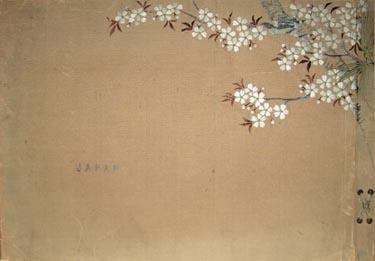Ogawa, K. (Kazumasa)
Takahasi, K:
Japanaj Vidajoj Kaj Moroj, Tokyo, Taisho 3 (1914), Oblong 8vo (19 x 25.5 cm), cardboard covers, 50 black and white collotype plates, no maps, organized in Western style reading from front to back. No text, just collotype plates printed on one side only of thin paper. Each plate has a typeset descriptive title in Esperanto and Japanese. There is a one page introduction (Antauparolo) by Ingeniero K. Takahasi of Hiroshima. Each plate measures 7 1/2 x 10 in - 19 x 25.5 cm. Image areas vary but are generally 6 x 4 1/2 in - 10.5 x 15.5 cm. The collotype plates cover a wide range of views in Japan with an emphasis on scenic, religious and historic places. While published in 1914, this is a later printing of a book that was first published at the turn of the century and captures views of Japan as the country passed into the 20th century. The plates in this book replicate those found in an English language edition published in 1917.
Publishing/Printing History, Sights and Scenes in Fair Japan (ca 1910~ca 1920).
- ca 1910 - Imperial Government Railways, 50 color collotypes and 2 color maps, captions in English only, here.
- ca 1910 - Imperial Government Railways, 50 black and white collotype plates, no maps, captions in English only.
- 1910 - First printing, published by Kelly & Walsh, 50 color collotypes, no maps, captions in English and Japanese.
- 191? - Second printing, not accounted for in the colophons.
- 1914 - Esperanto Version, Japanaj Vidajoj Kaj Moroj, 50 black and white collotype plates (same images 1917, below), captions in Esperanto and Japanese, here.
- 1916 - Third printing, "reproduced and published by K. Ogawa," 50 collotype plates, some color (probably same as 1917, fourth printing, below).
- 1917 - Fourth printing, "reproduced and published by K. Ogawa," 16 multipass color collotype plates, 34 black and white collotype, here.
- ca 1920 - Unknown printing, 53 black and white collotype plates, here.
For information on Kazumasa Ogawa, click here.
To see the title page, click here.
All plates are black and white collotpyes, plates and captions below are from the 1917 edition. The English captions are not found in this book and all the plates are black and white. I have provided below for general information only.
Title Page
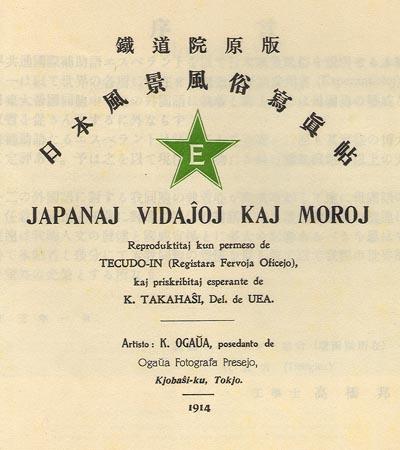
Collotype Plates
- La Cefa Enirejo de la Imperiestra Palaco, Tokio
(The Main Entrance (double bridge) to the Imperial Palace, Tokyo)
- Ueno Parko
(Uyeno Park, Tokyo -- When the Cherry Blossom Blows)
- Sinobazu Lageto apud Ueno Parko, Tokio
(Shinobuzu Pond, Tokyo, Famous Lotus Flowers)
- Pitoreska Pejzago de Cirkaufoso de la Imperiestra Palaco
(A Picturesque View of the Imperial Palace Moat (Naval Dept & Judicial Dept))
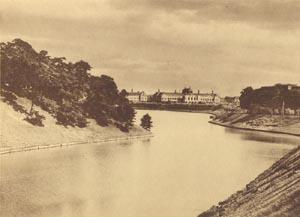
- Enirejo al unu Tombegoj de Tokugaua Sogunoj en Tokio
(Entrance to Mausolea of the Tokugawa Shoguns in Tokyo)
- Floroj de "Fuji"(wisteria) en Temmanguu Sanktejo, Kameido, Tokio
(Under the Wisteria Arbour -- In the Grounds of the Kameido, Temmangu Shrine, Tokyo)
- "Sobu" angle "sweet-flag" Gardeno Kamata apud Tokio
(Iris Garden at Kamata near Tokyo)
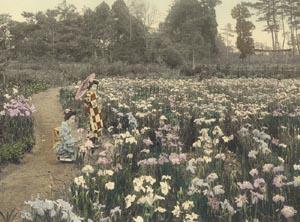
- Cefluktisto en Amfiteatro Kokugikan, Tokio
(A Champion Wrestler in the Kokugikwan Amphitheatre, Tokyo)
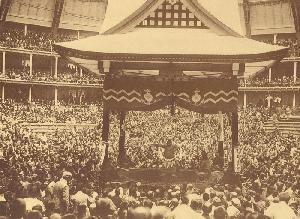
- Tipa Japana Logejo
(Typical Japanese Residence)
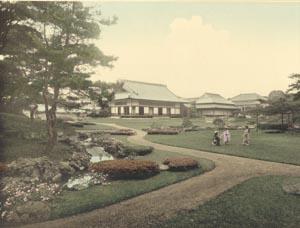
- Tipa Japan Gardeno
(Typical Japanese Garden)
- Tipa Salono ce Riculo
(Typical Reception Room in a Wealthy Home)
- "Daibucu," au giganta bronza Statuo de Budho en Kamakura, starigita en 1252
(The "Daibutsu," or Gigantic Bronze Statue of Buddha at Kamakura, Erected in 1252)
- Enosima ("sima" signifas "insulo" n) apud Kamakura, Pitoreska
(Enoshima, near Kamakura, a Picturesque Island and Popular Excursion Resort)
- Mijanosita, unu el satataj Banejoj de varma Fonto sur Hakone Montaro
(Miyanoshita, a Favourite Hot Spring Resort in the Hakone Mountains)
- Montego Fu'ji, malviva Vulkano de 3,740 m da Alteco
(Mt Fuji, Height 12,390 ft)
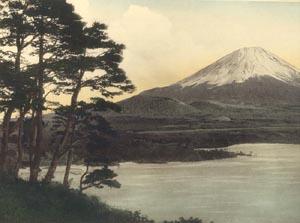
- Pupofesto pro Knabinoj
(Display of Dolls and Toys on the Girls' Festival in March)
- Armiletofesto pro Knaboj
(Display of Miniature Armour and Toys on the Boy's Festival in May)
- Armiloj kaj Kostumoj de antikvaj Militistoj
(Armour and Weapons of Ancient Warriors)
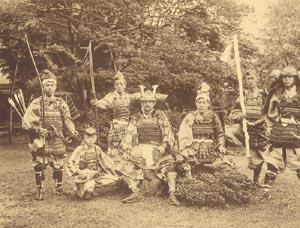
- Rivero Kiso en Centra Japanujo
(The River Kiso, Central Japan)
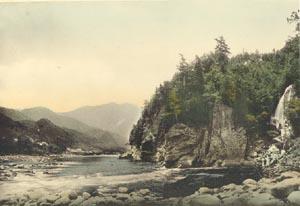
- Perkoraksa Fiskaptado (trutojn) sur Rivero Nagara en Centra Japanujo
(Cormorant-Fishing for Trout on the Nagara in Central Japan)
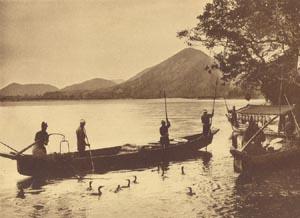
- Lago Biua apud Kioto
(Lake Biwa, near Kyoto, the Largest Lake in Japan and Noted for its Characteristic Scenery)
- Templo de Kijomizu, Kioto
(The Temple of Kiyomizu, Kyoto, Founded in 778)
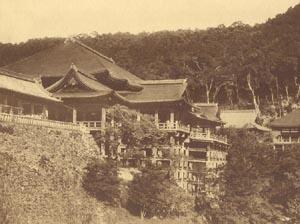
- Kinkakuji, au "Ora Pavilono" en Kioto
(Kikakuji, "Golden Pavilion," Kyoto)
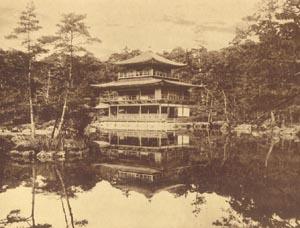
- (Guado de malvarmeta Ventto en somera Vespero surborde de Rivero Kamo, Kioto
Enjoying the Cool of a Summer Evening on the Kamogawa in Kyoto
- Higasi (orienta) Honganji Temple, Kioto, fondita en 1692
(The Higashi Hongwanji, Kyoto, Founded in 1692)
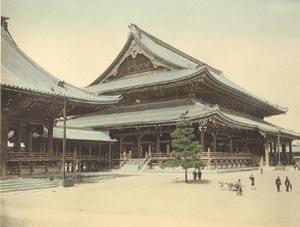
- Arasijama ("jama" signifas "monto" n) apud Kioto
(Arashiyama, Noted for Cherry Blossoms and Autumn Tints and also the Centre of Medieval Legends)
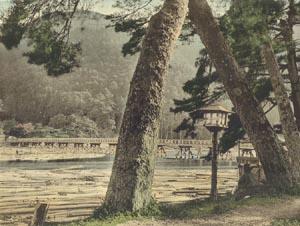
- Flosado sur Rivero Hozu
(Descent of the Hozu Rapids near Kyoto)
- Gloroj de Autuno-- Rugiginta Acerfolio en Toganoo apud Kotio
(The Glories of Autumn -- Maples at Toganoo near Kyoto)
- Arbopeonio Gardeno
(Peony Beds)
- Rica Elmontrajo de Krizantemoj
(A Rich Display of Chrysanthemums)
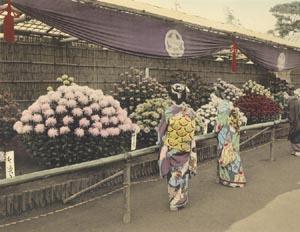
- Teoplantejo en Uji, 14 km suda de Kioto
(A Tea-Plantation with Tea Pickers at Work)
- Enirejo de Kasuga Sanktejo en Urobo Nara
(Entrance to the Ksuga Shrine, Nara)
- Hooriuji Templo staranta apud Urbo Nara
(Horyuki, near Nara, Built in 607, the Most Ancient Buddhist Temple in Japan)
- "Caoju," au Teoceremonio, unu el esoteraj Artoj en Japanujo
The "Chanoyu" or Tea-Ceremony, One of the Esoteric Arts of Japan
- Ludado de "Koto," Muzikilo havanta 13 Fedenojn, precipe ludata de altklasaj Virinoj
(Playing the "Koto," the Most Widely Used Form of Domestic Musical Intstrument)
- "Ikebana," au Florarangado, unu el esoteraj Artoj en Japanujo
(The "Ikebana" or Flower Arrangement, One of the Esthetic Arts of Japan)
- Amano-Hasidate
(Ama-no-hashidate, Central Japan, One of the Three Most Beautiful Sights in this Country)
- Kastelo de Himeji
(Feudal Castle at Himeji)
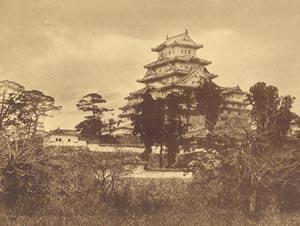
- Panoramo de la Enlanda Maro apud Urbo Onomici
(A Glimpse of the Island Sea; near Onomichi)
- Majajima, au Icukusima
(Miyajima, a Sacred Island in the Inland Sea, One of the Three Most Beautiful Sights in This Country)
- Ricurin Parko en Urbo Takamacu, Sikoku-unu el Japanaj Tipaj Gardenoj
(Ritsurin Park in Shikoku -- A Typical Landscape Garden)
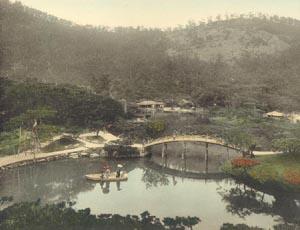
- "Noo," Speco de Klasika lira Dramo
(The "No," a Species of Lyric Drama of a Classical Nature)
- "Odori," Drama Danco en antikvaj Kostumoj
(The "Odori," a Dramatic Dance in Old Time Costume)
- "Odori," Drama Danco en antikvaj Kostumoj (Different Picture)
(A Characteristic Japanese Dance)
- Nikkoo Sanktejo, fondita en 1617
(In the Grounds of the Nikko Shrines, Founded in 1617)
- Aleo de "Sugi" (cryptomeria) apud Nikkoo
(Avenue of Crytomerias near Nikko)
- Macusima (pinarba insuletaro) apud Urbo Sendai en Norda Japanujo
(Matsushima, in Northern Japan, One of the Three Most Besutiful Sights in This Country)
- Gan-ecu Fervojo laulonge de Rivero en Norda Japanujo
- Cijono-Macubara (pinarbaro de Cijo) apud Urbo Hakata en Kiusuu
(Chiyo-no-matsubara, a Celebrated Pine Grove in Kyushyu (Pic of Stean Train))
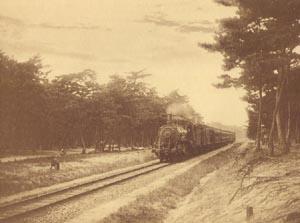
- Monto Aso, viva Vulkano en Kiusuu
(Mt. Aso and Active Volcano in Kyushu)
Because of scanner limitations, the right hand side of each picture is one inch shorter than the actual image.
Colophon
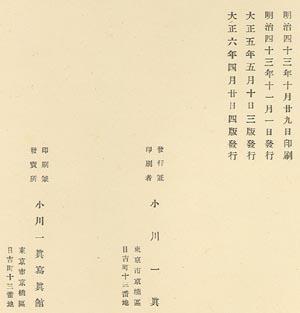
Printed - 1914 (Taisho 3).10.28
First Distribution - 1910 (Meiji 43).11.1
Third Distribution - 1916 (Taisho 5).5.10
Fourth Distribution - 1917 (Taisho 6).4.20
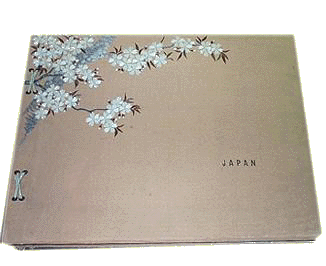
Cover from the edition with
50 black and white collotypes
Date Unknown.
|


